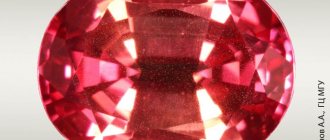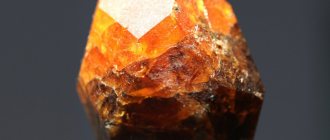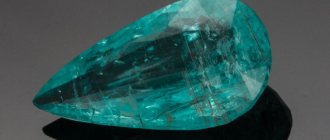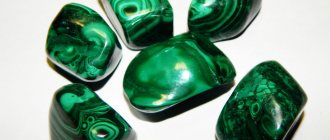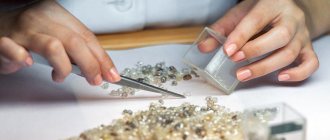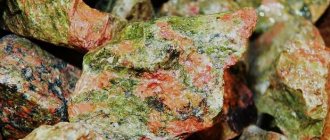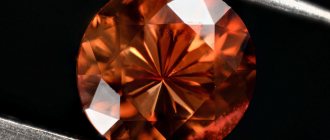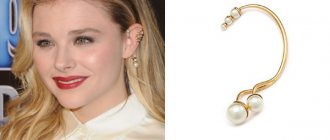Gems are a wide group of natural stones, predominantly of a crystalline nature. In the world, there are about 4 thousand names of minerals of various degrees of hardness and wear resistance: transparent, opaque, painted in plain colors or with a pattern, matte or shiny surface, etc. Only 100 of them, or a little more boldly, can be called gems.
According to different classifications, they often include transparent stones, while non-transparent minerals and rocks are classified as “colored stones.”
There are many legends and incredible facts about gems, learning which is just as interesting as admiring the iridescent facets of a transparent royal diamond, soft blue aquamarine, blood-red ruby or hyacinth.
Diamond the size of the moon
Diamond is the king of gems and the hardest gemstone. The largest diamonds on Earth are considered to be “Cullinan I” or “Great Star of Africa” ( 530.2 carats ), “Cullinan II”, “Century” and others: “Star of Yakutia”, “Orlov”. But there are much larger examples in the Universe.
Thus, astronomer Travis Metcalf discovered a diamond planet in the constellation Centaurus in 2004. The size and value of the cosmic gem is difficult to imagine - it is about 10 billion trillion carats. The object was named “Lucy” by analogy with the Beatles hit “Lucy in the Sky with Diamonds”.
First beginnings
VIA “Gems”
Very soon the music of “Gems” leaked into the “Mayak” , as well as into many other then quite successful programs and radio stations! The ensemble’s first live concert took place in the summer theater of the Hermitage in Moscow: after performing several of their songs, “Gems” literally made the Soviet public fall in love with them...
From time to time the composition of the ensemble changed, and, ultimately, the so-called “golden composition” was formed: it included Irina Shachneva, Eduard Krolik, Sergei Berezin, Gennady Zharkov, Valentin Dyakonov, Nikolai Rappoport, Yuri Genbachev, Anatoly Mogilevsky and Yuri Peterson . It was with these members that VIA “Gems” saw its best period in terms of hit songs - the compositions “I’ll take you to the tundra”, “Your whole life is ahead”, “If you are young at heart” and others became the personification of the Soviet music scene of the 70s! And the song “My address is the Soviet Union” became the hallmark of the ensemble...
Alexandrite – a chameleon stone
Alexandrite, named after Alexander II, was officially discovered in the Ural Mountains at the beginning of the 19th century. But its property of changing color in daylight and evening light has been known for a long time. It is no coincidence that in the East it was called “iridescent”. Other gems also have this property to some extent. Thus, aquamarine brightens a little in the sun, and peridot loses its yellowness in evening light.
The main stages of creativity
VIA "Gems"
"Gems" fell in love with the general public, as they sang about what is important and close to every person - about love, about their native land, about the romance of difficult roads, about the dilemmas that worried Soviet youth... It was one of the few vocal and instrumental ensembles USSR , whose sound was truly patriotic...
Since 1972 , “Gems” began touring and participating in major music events. Their first breakthrough was participation in the hit festival in Dresden! There, subsequently, a record with four songs of the group will be released... Afterwards, the Soviet ensemble will perform in Warsaw, Berlin, Prague, Havana, Milan , and even in the countries of Latin America and Africa ! Needless to say, what a stunning and simply gigantic result this was for the team from the USSR ! At the same time, “Gems” did not forget about their homeland, which they also enjoyed traveling around with concerts... In particular, the group’s favorite concert venue was Luzhniki .
Closer to the mid -70s, “Gems” gave ten concerts in ten days, despite weather conditions and other nuances! Their concerts were sold out - about 20 thousand people came to see the popular Soviet ensemble!
The healing properties of gems - myth or reality?
Since ancient times, it was believed that minerals have the ability to cure diseases, bring good luck and money, and attract love to their owner. For example, they believed that they were endowed with such magical qualities:
- Carbuncle.
- Chrysolite.
- Coral.
- Pearl.
- Amethyst.
- Pomegranate.
- Agate.
- Sardonyx.
- Topaz.
- Turquoise.
- Sapphire and other stones.
And now the properties of gems are correlated with the signs of the Zodiac and it is recommended to carry “your” stone with you. According to the testimony of V. Dahl, it is known that A.S. Pushkin considered his emerald ring a talisman that bestowed talent. But there is no scientific proof of the healing power of stones. But lithotherapy is still widely used in folk medicine.
Precious luxury of gems
What do we call gems? These are stones of natural origin that have painted themselves in different colors. And they did this a long time ago and very deep... Deep in the earth, where they were formed over thousands of years. The origin of any gem can be compared to its maturation. Roughly speaking, when layers of sand characteristic of this particular type of stone grow around a grain of sand of a certain chemical composition. This happens as a result of earthly cataclysms, temperature changes, volcanic eruptions, displacement of the earth’s crust, and different temperature conditions in one or another part of our planet.
This is how what we call ornamental, semi-precious and precious stones are born. Some gem deposits are being depleted, at least those that we know of. Some are still full of riches, and many have not yet been found.
The photo shows the work of the famous Irkutsk craftswoman, stone carver Natalya Bakut (Made in collaboration with D. Belomestnykh). Stone figurine - Nugget. The work uses green, white and brown jades; orthoamphibolite, lapis lazuli, rauchtopaz, rock crystal, marble onyx, industrial jasper, silver, gold.
Aquamarine - both for the feast and for the world
Today, the “gem” industry fills two large niches: the production of jewelry inserts for jewelry, as well as the production of various products from stones, the same jewelry, figurines, dishes, and other consumer products. And the second is the sale of minerals and gems in the form of natural geodes, druses, crystals - in their pure form, in the form in which they were found in nature. This is already a subject of interest for collectors, researchers, and professional gemologists (people who deal with stones professionally).
Below is the gemstone raw material of aquamarine. This is exactly what it looks like and is found in nature. Each “glass” tube is a separate aquamarine crystal, which is often purchased to be used in jewelry settings or in its natural form.
Crystals grow in the ground the same way a salt crystal grows in school lessons. However, under different conditions and in different places on the planet, crystals of precious and semi-precious stones turn out differently. Stones are distinguished according to an approved specification: by purity, transparency, color saturation, chemical composition, and hardness. The mentioned aquamarine has a color ranging from completely transparent with a green tint to blue. Green aquamarine is found in the Urals, transparent and blue - in Baikal. Aquamarine is also mined in Brazil, India, Ukraine, Madagascar, and Pakistan.
Among the ancient Romans, aquamarine was considered the stone of the nobility and was the most expensive gem. Until now, the symbolism of aquamarine is associated with love, with luck in finding a partner, with a happy marriage and peace in relationships. Aquamarine is a powerful amulet, especially for sea travel and in the air. And among the Egyptians, aquamarine was revered as a guide to the other world. They believed that this gem united our worlds and gave the owner of aquamarine the power of all his ancestors.
Aquamarine is the brother of emerald, they are both beryl, large aquamarine crystals are very expensive. This stone, like other beryls, is valued by its crystal size. The larger the stone in the jewelry, the more expensive it is, especially if the craftsman used the crystal core itself for the core of the jewelry insert. A small stone costs very little, almost nothing. Only large specimens are valued.
This applies to all precious and semi-precious stones. A large specimen increases in price exponentially. A crumb of the same emerald costs very little or nothing.
Celebrities sparkle with large aquamarines on the Oscar path and in everyday life. This gem is surprisingly versatile - it can be worn both at a feast and in peace.
At world auctions, the price of aquamarine cabochons, if it is sufficiently pure and transparent, has never been small.
The many faces of tourmaline - from green to pink
An absolutely luxurious stone - tourmaline. It is also loved by celebrities and is kept in the best treasuries in the world. In crowns, in scepters, in royal museums and chambers. This amazing stone has up to 50 shades of color - from green to pink.
Depending on the color and transparency, some varieties of tourmaline are classified as precious stones, while others are classified as ornamental stones. The most valuable are the transparent varieties of green (verdolite), blue (Paraiba) and crimson-red (our rubellite), as well as polychrome green-red (watermelon, two-color). Here in Siberia, tourmaline-rubellite is mined, a bright pink stone, which in turn has a lot of shades. It is also called noble tourmaline.
The best examples of tourmaline are often found on carpets.
In the photo, Gwyneth Paltrow is wearing earrings consisting of two pear-shaped rubellite cabochons, framed with blue, pink and purple sapphires. Selena Gomez showed off a pink tourmaline ring in a simple design.
Tourmaline captivates, first of all, with its transparency, purity of color, and nobility of shades. The so-called defect-free crystal is of great importance; simply put, it is a stone without cracks or inclusions. But sometimes it is the internal filling of tourmaline, its transparent specimens, that, instead of reducing the value of the stone, on the contrary, increases it. The talent of a master working with stone is to discern at the base of the crystal, the very “grain” that will give the decoration a zest. A transparent, as they say, cracked plate of noble tourmaline sometimes looks simply stunning in jewelry.
Tourmaline is often counterfeited, or rather, a fake is passed off as tourmaline, but it will not be difficult for a professional to identify the deception.
Today it is necessary to distinguish between cases of counterfeiting or counterfeiting, when simply glass, resin, or even plastic can be passed off as a noble stone. And the case when the stone was refined. Many stones are being refined or, in professional slang, “treated” today. The cracks are filled with a special composition, the stone is subjected to heat treatment or, as is often done with diamonds, they are treated with a laser. Of course, a stone that has undergone processing cannot be considered as expensive as the stone or crystal for which they want to pass it off. Nevertheless, these are also jewelry, precious stones, which simply have less value than their natural counterpart.
That is, there are simply fakes (deception in its purest form), then there are refined stones (almost all emeralds on our market are “treated”, that is, processed to enhance color), and there are synthetic stones grown in a laboratory. Jewelry stores in big and small cities are filled with them.
They grow diamonds (diamonds), emeralds, rubies, sapphires and many precious stones, which are in constant demand. A synthetic stone is also a crystal, it’s just created artificially. As for shine, in some cases it will sparkle even more than its natural counterpart. It’s just not natural, but, roughly speaking, from a test tube.
But let's return to our tourmalines.
Another variety of tourmaline is black tourmaline (schorl). And this is without a doubt the stone of sorcerers. Black tourmaline is credited with extraordinary strength. First of all, it is believed that if someone wishes you harm, then black tourmaline in the form of a talisman will protect and, most importantly, direct the negativity back.
Jewelry made from black tourmaline must certainly touch the body. That is, the reverse side of the cabochon or jewelry insert in the product must be open and in contact with the skin (by the way, the same thing is said about white jade, which is worn for the purpose of healing).
For example, the Chinese, big fans of tourmaline, including black (they call any tourmaline “pi-si”), are absolutely sure that black tourmaline is a wizard’s stone. And that with such an amulet stone it is not scary to get involved in any business adventure. All forces that will interfere with the execution of the plan will return back to those who let them go. And the owner of black tourmaline will always be successful.
Black tourmaline is for a person who “has a third eye,” let’s call it intuition, like a guiding star for a sailor. Immediately the goals become clear and the obstacles disappear.
Thus, according to magicians and psychics, the presence of black tourmaline among jewelry or amulets guarantees success in everything.
Pictured is black tourmaline from Nigeria
From ancient times to the present day, the tradition of belief in the magical power of stones has been alive. There is no point in disputing this, because faith protects, and our thoughts are what ultimately happens to us.
Jade - magical leader
The record holder for magical veneration among ornamental stones is jade. Because the main buyers of jade are the Chinese. They have believed in jade since time immemorial and jade is revered today by modern Chinese no less than it was 100 and 200 years ago. The reserves of Chinese jade have been depleted; since ancient times, four types of jade were mined in China, but every Chinese had to buy jade for himself. Now the Chinese are buying jade from Russia. Jade is Buddha. Jade is China. White jade is Buddha's saliva. When a Chinese person puts a white jade pebble in his mouth, he connects with the Buddha.
Green jade, which is mined in Siberia, is used to make everything: jewelry, amulets, massage devices, including intimate massage, frying pans for cooking, stoves for frying meat, figurines for the home, vases, dishes...
It is believed that jade is the warmest stone in the world. And considering that when heated, jade really retains heat for a long time, this is true. Jade helps heart patients, helps those who have problems with the endocrine system, skin problems. If you have problems with the kidneys or stomach, it is recommended to wear jade on your belt. It is believed that jade helps in childbirth and strengthens the immune system of its owner.
Jade massage has many techniques, and what is surprising is that even doctors recognize the ability of jade to heal.
The smoothness of polished jade, its beauty and durability are the main reasons for the popularity of this stone. Good jade is not cheap; individual specimens of jade, both green and white, have collector's value.
The Russian jeweler Carl Faberge used jade in his beautiful products, fulfilling orders from the royal family, cigarette cases, notebooks and prayer books, jewelry boxes, and complemented jade with gold, gems, and coinage. Today these items are worth millions and periodically appear at auctions.
A master who works with jade knows that this stone is very grateful. The rich green color after polishing acquires the warmth of real natural greenery, which is difficult to compare with the fakes that have flooded the world under the guise of jade. The color of jade—sometimes bright, sometimes muted—always remains very natural, pleasing to the eye. Jade does not have any shades of turquoise or azure, no sparkles or foreign inclusions. It is smooth and at the same time branched when exposed to light, and is almost always translucent.
Do you know that not so long ago among the jades, and there are several of them: green, cat jade (with the effect of a cat's eye), black, brown, white and red, blue jade appeared not so long ago. They gave it a name - Dianite. It was discovered in 1997, the same year Princess Diana died. Professional gemologists do not recognize this name because they believe that it is absolutely not scientific.
Professionals call it blue jade or blue jade.
Today Dianite is the most expensive of the jades. Due to the fact that it is still very rare.
White jade, which has already been mentioned, has a cult significance throughout Asia. Mythology and reality are so intertwined in the minds of a Buddhist that the possession of a simple pebble of white jade is already considered a sign of an accomplished personality.
White jade pebbles are a natural oval or round pellet with an obligatory “crust” (a dark brown coating, usually on the other side of the pebble), with a main color of white, reminiscent of the color of lard or milk. In general, everything related to white food is sacred to Buddhists and shamanists. White jade has a lot of color varieties, inclusions of yellow, brown, the white part of the stone itself can be bluish in places or with shades of green. Natural pebbles or pellets are already considered a finished product made by nature itself.
A superb example of a white jade pebble that could be a complete work of art in itself. Only the author of this product is nature itself.
Such stones are used to make amulets, figurines, or left as is. Sometimes they are purchased simply for collection.
Below is a magnificent product from Irkutsk stone master Natalya Bakut. Scorpion. Do you think this is jade?
Scorpion. Noble serpentinite, crystal, white gold. N. Bakut, A. Baydrakova, O. Selivanchuk
This is not jade, as it might seem at first glance. This is a noble serpentinite or coil, which, by the way, is used to decorate the Shchelkovskaya metro station in Moscow. Beloved by sculptors and stone artists. Also one of the most interesting stones, with a rich palette of colors and interesting properties. By the way, no less magical than jade. Traditionally, tramps and travelers carried it with them as a talisman; it was believed that it protected against snake bites, saved from hypertension, colds, the serpentine was even called an apothecary stone.
This stone not only saves its owner from various troubles, but also becomes so attached to its owner that it cannot be re-gifted. Can only be passed on to blood relatives.
Many people confuse noble serpentinite with jade, but they have completely different compositions.
Tanzanite - the famous "blue diamond" from the Titanic
One of the discoveries of recent years is the Tanzanite stone, which got its name from the country of Tanzania, where it was discovered. Like Siberian Dianite, Tanzanite was discovered quite recently - in March 1966, a little over 50 years ago.
At first, the piercingly blue stones found were mistaken for sapphires, but they were soon identified as the new mineral tanzanite. Tanzanite quickly gained worldwide fame thanks to the American jewelry company, which proposed the name in honor of Tanzania, where there is the only deposit of this beautiful stone in the world. Its popularity was facilitated by clever advertising policy, rarity, magnificent color and the use of jewelry made from it by film star Elizabeth Taylor.
It is found in blue, purple and yellow-brown colors; the latter, after heat treatment, also become blue-violet and are used in jewelry.
Good quality stones are ultramarine or sapphire blue in color. When exposed to electric light, it takes on an amethyst-violet hue. When heated to 400-500 °C, brownish and yellowish shades disappear and the blue of the stone deepens.
Tanzanite can be confused with natural and synthetic sapphire.
The most famous tanzanite was used in James Cameron's Titanic instead of the blue diamond Heart of the Ocean.
Tanzanite is a symbol of love, luxury and wealth. It can be cut, cabochons can be made from it, it remains a magnificent blue crystal, which has already found its niche among the elite jewelry of the modern jewelry fashion industry.
Charoite - magic in stone
Charoite is a stone found on the Chara River in Siberia. The only deposit in the world of such stone. It has no analogues. What events that took place in this particular part of the globe that preceded the creation of this unique mineral can only be told by super-professionals. Researchers have still not come to a consensus on what influenced the birth of the delightful lilac stone, pierced by radiant crystals of different rocks.
Charoite, like tanzanite, is found and mined in only one place in the world.
The charoite deposit is located at the junction of the Irkutsk region and Yakutia. The government of the Republic of Sakha-Yakutia has imposed a limit on stone extraction of 100 tons per year - this is a forced measure to protect against the rapid depletion of the deposit. That is why the charm increases in price from year to year and becomes more and more rare.
There is a remarkable story associated with the discovery of charoite. The discoverer of the field, Yuri Rogov, was sent by the government on a business trip abroad. There he went to the Louvre Mineralogical Museum, which claimed to have a complete collection of all the minerals of the Earth and, showing a plate of lilac rock, asked to identify the mineral. The museum staff were forced to admit that they did not have such a mineral, and offered to sell him a sample. But the Soviet geologist refused.
A collectible specimen of charoite looks completely “alien”
Products and jewelry made from charoite delight everyone who sees it for the first time. An absolutely natural lilac color, piercingly bright and sparkling, at the same time, thanks to its luminous veins and inclusions of moonstone, charoite looks like a meteorite from another planet.
According to its quality and consumer properties, charoite is divided into several classes.
The most magnificent charoite has the Extra class. The extra class includes bright lilac specimens with mother-of-pearl interlacing of feldspar crystals (this is moonstone), interspersed with metal sulfides and other alloys. In the extra class there is very little black and other alien color shades.
Possession of natural stones that Mother Nature created is beyond the philistine concepts of “fashionable-not fashionable”, “expensive-not expensive”... Each item from this “catalog” is truly priceless. You can buy it only because you want to have it. Look at her any time you want. Carry on yourself, carry in your pocket, have in your box. And it will never happen again. She will be only yours.
A true connoisseur of stone is delighted by the thought that such beauty (pink, green, blue...) was created somewhere deep in the earth, and then came into being through the efforts of a successful miner, and was later cleared of other rocks, processed by a master and transformed - either in an ideal cabochon shape, or in a faceted insert for a ring, earring or something else... The stone rose from the depths, was cleansed, saw the sun's rays, sparkled with all the colors of the rainbow, sparkled and shone... And now you can touch, touch, stroke it ...
The mere thought that this transparent drop from the very depths could be somewhere nearby, one’s own, one’s own, is the epiphany of a true artist. And the artist and creator lives in each of us.
As children, we look at beautifully sparkling glass from our mother and grandmother’s box...
In our youth we wear rhinestones and sequins...
And then, later, when we can allow ourselves to see real beauty, we begin to hear the music of natural stones.
Asterism – natural “star-like” appearance of gems
Some minerals have a special decorative effect - from different angles and when moving the gem, a star of 3, 4 or more rays is visible in it (up to 12 rays in rubies). The nature of this phenomenon is due to the fact that crystals often contain inclusions of other crystals. Light, refracting in them in a special way, creates a star pattern that can be observed in corundum, ruby, beryl, emerald, aquamarine, sapphire, heliodor, diopside. Artificially grown stones can also be given this effect through various inclusions during their production.
Groups of gems according to A. Fersman
Considering that the most important indicator, according to A. Fersman, was hardness, he identified three main groups of gems: from harder (first) to less (third).
The scientist included in the first group: diamonds, rubies, sapphires, emeralds, spinels, alexandrites, euclases. In the second: topazes, aquamarines, beryls, amethysts, demantoids, red tourmalines, almandines, base opals, zircons, hessonites. The third, most extensive, A. Fersman included: cardierites, rock crystal, epidote, amber, labradorite.
epidote bracelet
Massive study of gems in the USSR began in the 60s of the last century. Then a specialized enterprise “Soyuzkvartsamotsvety” was even created, the main activities of which were conducting expeditions to search for new deposits and scientific work in this area. As a result, a separate “gemstone” industry was even created in the national economy of the country.
In those days, A. Fersman’s classification was supplemented by Soviet scientists. Many scientific works have appeared on this topic. And colored ornamental stones were classified as an expanded category of semi-precious stones.
First difficulties...
However, gradually the “stern” of the musical ship began to crack... Already in 1975, most of the composition left the group, founding VIA “Plamya” , and Yuri Malikov “Gems” in less than a month , practically from scratch: with Alexander Brondman, Evgeny Kurbakov , the production group and Vladimir Vinokur, who had just been enlisted as a soloist. It is worth noting that the updated composition included real professionals in their field! It included, for example, drummer Vladimir Polonsky from “Jolly Fellows” , as well as Vitaly Kretyuk , who worked with the Russian prima donna Alla Borisovna Pugacheva in the ensemble “You, Me and the Song” .
Gradually, the Gems improved the visual image of their performances, however... in the mid- 1980s they began to rapidly lose their popularity. We can say that they fell out of the “trend”: new names appeared on the scene, such as “Tender May” and “Mirage”, and “Gems” ... and what about “Gems”. The listener began to forget about them.
History of creation
After graduating from the Moscow Conservatory in early 1970, Yuri Malikov was offered to go to the international exhibition EXPO-70 in Japan. There he became interested in modern music. The young musician was especially interested in its technical side. As a result, he spent all the money he earned in eight months in Japan on the purchase of musical instruments and equipment. In total, Yuri Malikov brought 15 boxes of equipment to Moscow. And he immediately began organizing a musical ensemble.
There is no exact date of “birth” of VIA “Gems”. At the end of 1970, the ensemble gathered for the first rehearsal. By June 1971, the team's first program was prepared and approved. And on August 8 of the same year, on the air of the radio program “Good Morning!” his debut took place. The first songs of the then unnamed group were the Russian folk “Will I go, will I go out” and a new song by M. Fradkin to the words of M. Plyatskovsky “I’ll take you to the tundra.” At the same time, radio listeners were asked to come up with a name for the new ensemble. In October, from several tens of thousands of letters sent and almost 1,200 options, the musicians chose “Gems”. And at the first solo concert at the end of 1971, the ensemble performed under this name.
VIA "Gems" today
Since 1996, members of the ensemble from different years have performed under the “Gems” brand: Y. Malikov, I. Shachneva, V. Belyanin, G. Rubtsov, S. Belikov, V. Dyakonov, E. Presnyakova, O. Sleptsov, A. Nefedov, G. Vlasenko and others. The musicians' repertoire includes more than five hundred songs, many of which have already become classics of the national stage.
In 2006, in honor of the 35th anniversary of Samotsvetov, Inna Malikova decided to create a new musical group that would continue the work of the legendary ensemble of Yuri Malikov. Thus the New Gems were born.
Creative respite and “New Gems”
“New Gems”
The beginning of the new decade brought its own surprises to fans... So, in 1992 Malikov decided to suspend the activities of his brainchild. At the time of the “creative pause,” he devoted himself to television shows and videos, and also headed the jury of song competitions. During this period, VIA members also took up their own projects: Alexander Nefedov went into a solo career, Oleg Sleptsov created his own group, and so on... At some point, “Gems” disappeared from the view of the listener, and if only that... The number of their fans is significant decreased.
Only in the mid -90s the group was revived. Of course, she no longer saw the success she once had, but she is still in demand to this day! In 2006 , Yuri Malikov, together with his daughter Inna Malikova, founded New Gems . So - the Soviet ensemble continued to live even after the collapse of the USSR!
Sergei Grigorievich Belikov
Honored Artist of the Federation was born in the Moscow region on October 25, 1954. After graduating from music school, he began working in the theater. He was accepted into the Araks team. Around the same time, he entered the Institute of Culture to become a music teacher.
He was invited to join “Gems” in 1976, but a year later he left the team and returned to the previously abandoned group. From 1974 to 1980 he participated in famous theater productions. Closer to '81 he returns to Gems. Four years later he begins his solo career.
Good attitude towards football. He is a member of the pop star team, where he plays the role of scorer.
Discography
- 1973 – “My address is the Soviet Union”
- 1973 – “Gems”
- 1975 – “With us, the young”
- 1980 – “The Path to the Heart”
- 1983 – “Weather Forecast”
- 1995 – “Beyond the Clouds”
- 1996 – “Everything I have in life”
- 1996 – “Twenty Years Later”
- 1997 – “We have become different”
- 2000 – “The Best”
- 2001 – “Boulevard of Stars”
- 2001 – “Records of the 70s, 80s”
- 2003 – “Kolokolenka”
- 2003 – “First Love”
- 2006 – “New mood for love”
- 2009 – “Grand Collection”
- 2009 – “NEW Gems”
- 2010 – “Golden Hits”
- 2010 – “With us, the young”
Encyclopedia
“GEMS” is a vocal and instrumental ensemble (VIA) led by Yuri Fedorovich Malikov (born in 1943). Honored art. RSFSR (1986). Graduate of Moscow. conservatory in double bass, he already had experience working in pop and symphony orchestras. The professionalism of the director contributed to the rapid development of the ensemble - the debut of “Gems” took place at the Hermitage Variety Theater in the summer of 1971. The first lineup, along with Malikov, included Sergei Berezin, Yuri Peterson, G. Zharkov, V. Dyakonov, Anatoly Mogilevsky, Yu. Genbachev, singer I. Shachneva, in 1975 they all organized the ensemble “Flame” led by Berezin; Malikov recruited a new lineup of Gems. From the very beginning, “Gems” took the path of performing Soviet songs addressed to the widest and most diverse audience.
It is no coincidence that this is one of Mosconcert’s most popular groups, intended for performances at various venues - from stadiums to rural clubs. The repertoire of the early 70s included songs by Soviet composers of different generations: Mark Fradkin’s “I’ll Take You to the Tundra” (art. Mikhail Plyatskovsky), the first song that brought popularity to the ensemble; songs by David Tukhmanov - “My address is the Soviet Union”, “The rains have come” (both at V. Kharitonov station); songs by young authors - “Villow” (Eduard Khanka, art. Yuri Rybchinsky), “Young and Green” (S. Tomina, art. Igor Shaferan). By 1975, the circle of authors expanded significantly. “Gems” sing Vyacheslav Dobrynin’s songs “Oh, these dances”, “We, the young”, “I don’t love your flowers” - all on the station. Kharitonov, “Love lives on earth” - art. Leonid Derbenev, includes in the repertoire songs by Vladimir Shainsky (“Ledum”, art. Plyatskovsky), Nikita Bogoslovsky (“Song of Friendship”, art. Mikhail Tanich). Fradkin’s songs also remain popular with the audience - the lyrical “Good Omens” (art. by Evgeniy Dolmatovsky), the tragic, harsh “Uderevni Kryukovo” (art. by S. Ostrovoy), the military “For that guy” (art. Dolmatovsky). The ensemble is noticed by Robert Rozhdestvensky, whose poems are used to write the songs “All Life Ahead” by A. Ekimyan, “There, Beyond the Horizon” (“There, Behind the Clouds”) by Mark Fradkin, who gained fame in the performance of “Gems”.
The collaboration with “Gems” gives birth to E. Martynov’s song “If you are young at heart” (Art. A. Dementyev). After touring Latin American countries (1975, Colombia, Argentina), Gems are working with a completely new line-up and in a different direction. They are gradually abandoning the performance of traditional songs by famous composers, and are expanding the circle of authors who write specifically for VIA. Dobrynin (“Everything I Have,” art. Derbeneva, 1976; “Be Happy,” “First Day,” “Someone else’s Wedding,” art. M. Ryabinin, 1977), Alexey Mazhukov (“Releasing the Tit,” 1978 ). The practice of VIA, when, according to the head of “Gems” Malikov, “everyone sings a little, everyone plays a little, but on the whole something works out,” is gradually reoriented towards more significant works. The main ones along this path are the extraordinary songs created by the ensemble - “Mirror and the Fool” (Malikova, Vladimir Presnyakov Sr., senior V. Sautkina and S. Belikova, 1982), “Money”, “Flowers on the Asphalt” (Belikova , Art. V. Dyunina, 1982), lyrical folk ballad “How John Got Married” (Belikova, Art. A. Dolsky), bright disco melodies “Kangaroo, Kangaroo!” (Belikova).
In the late 70s and early 80s, “Gems” turned to theatrical forms: the theatrical suite “Francisco Goya”, music. V. P. Presnyakov, musical performance “The Magic Shooting Game”, libretto by B. Purgalin and B. Salibov, music. Malikova and V.P. Presnyakova, director G. Kantor, 1984. Soloists A. Nefedov, O. Sleptsov, E. Presnyakova (Kobzeva), G. Vlasenko, E. Kurbatov, V. Belyanin. At different times, A. Glyzin, V. Kuzmin, A. Barykin worked in the ensemble. In 1992-1994, concert activity almost ceased. In 1995, “Gems,” a self-supporting group at the Mosconcert, celebrated its 25th anniversary with a series of concerts (Presnyakov released the album “Saxophonic hits of all times and peoples,” 1997). The previous composition under the leadership of Malikov is replenished with part of the composition of VIA “Plamya”: Shachneva, Dyakonov, V. Anikeenko. Two groups work independently. Along with the new repertoire, they perform retro programs, create theatrical shows, and release discs with recordings of retro programs. L. Bubennikova
Alexey Sergeevich Glyzin
Glyzin is now 54 years old (born January 13, 1954). Along with his general education, he also received a musical piano degree. I didn’t finish school; after the 8th grade I transferred to a technical school. He left this educational institution and began working in an ensemble.
He studied full-time at the Institute of Culture. Before going to work at Gems, he was a soloist in the Dobry Well Done ensemble. He moved to Yuri Malikov in 1977, but did not last more than 12 months. After him he moved to Rhythm, which accompanied the pop star Alla Pugacheva.
For nine years he was the lead singer of “Merry Guys”. In this group he performed quite a lot of hits. His career is very successful: he has released many albums and several collections of songs.

